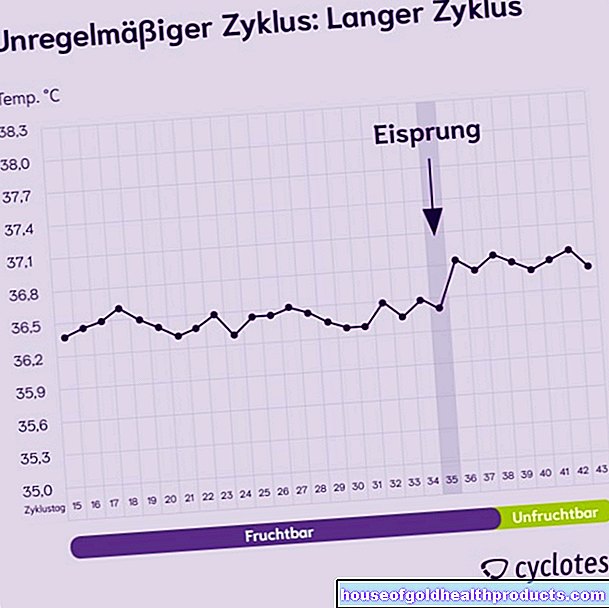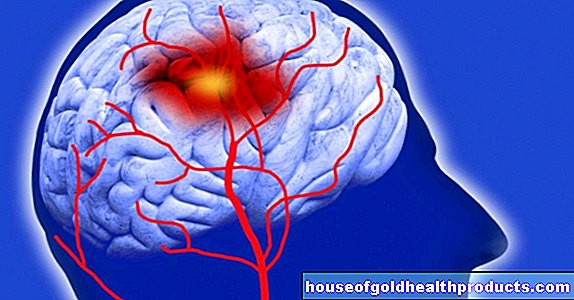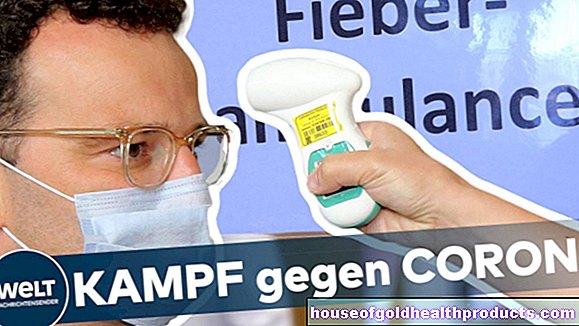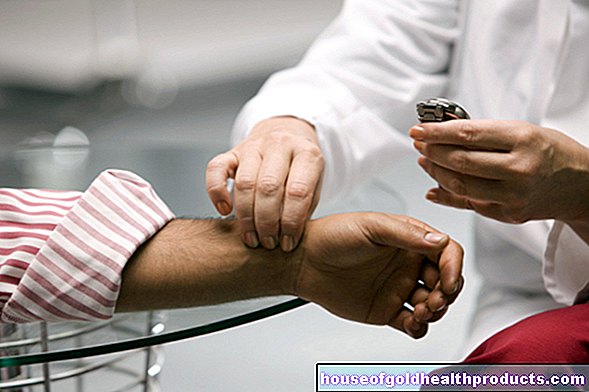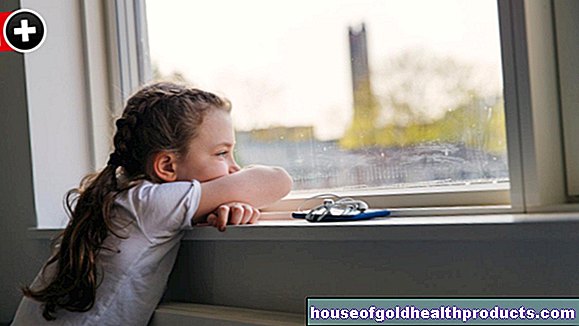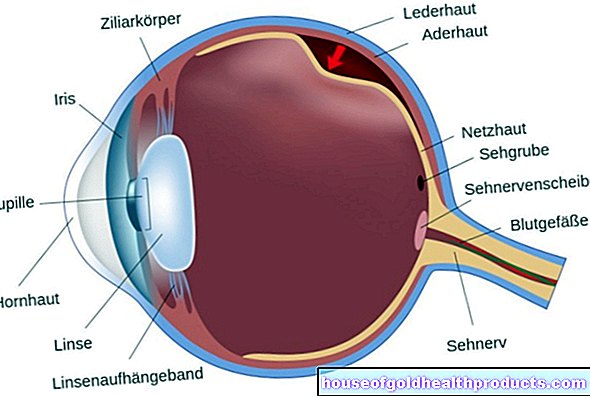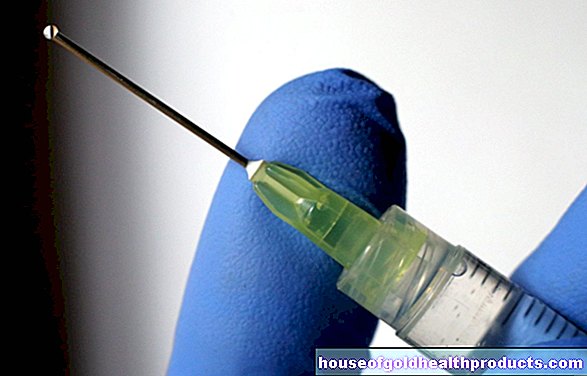myopia
Ricarda Schwarz studied medicine in Würzburg, where she also completed her doctorate. After a wide range of tasks in practical medical training (PJ) in Flensburg, Hamburg and New Zealand, she is now working in neuroradiology and radiology at the Tübingen University Hospital.
More about the experts All content is checked by medical journalists.Nearsightedness (myopia) is a common form of ametropia and often has no disease value at all. It can appear in childhood and can be treated well with glasses, contact lenses or an operation. Myopia can improve or worsen on its own over the course of life. Dangerous secondary diseases rarely occur. Read everything you need to know about myopia here.
ICD codes for this disease: ICD codes are internationally recognized codes for medical diagnoses. They can be found, for example, in doctor's letters or on certificates of incapacity for work. H52

Myopia: description
Myopia is a congenital or acquired ametropia of the eye. If you are nearsighted, you can usually see well up close, while objects in the distance appear blurry (with farsighted people it is exactly the opposite). A short-sighted person does not generally see worse. At close range it can even be superior to a person with normal vision.
How pronounced the ametropia is is measured in diopters (dpt). Someone with a negative reading is myopic, and the higher the digit after the minus, the more so. A reading of -12 D, for example, describes severe myopia, i.e. severe nearsightedness.
Strictly speaking, nearsightedness is usually not a disease at all. Up to an ametropia of minus six diopters, it is only considered an anomaly, i.e. a deviation from the average value. Pathological (diseased) myopia is only present if the ametropia is more severe.
How common is myopia?
The proportion of nearsighted people in different age groups varies. According to the Federal Statistical Office, there are almost four times as many nearsighted people in the population up to an age of around 40 as there are farsighted people. After that, the proportion of farsighted people increases. From the age of 50, almost twice as many people are farsighted as nearsighted. So farsightedness is more likely to occur in the elderly, while myopia is more common in children and young people. Men are somewhat less likely to be ametropic than women.
Myopia simplex and Myopia maligna
Experts differentiate between myopia simplex (simple nearsightedness) and myopia maligna (malignant nearsightedness):
Myopia simplex is also known as school myopia. It begins in school, usually around the age of ten to twelve. In the following years it can worsen and then usually remain stable from the age of 20 to 25. Most people with this type of myopia achieve diopters of -6 diopters at most. In a small part, myopia worsens to -12 D and only stabilizes up to the age of 30.
Myopia maligna, on the other hand, progresses further into adulthood. It therefore has real disease value. Consequential damage can also occur, such as tissue damage with the formation of small scars or holes in the retina, which can also lead to retinal detachment. Glaucoma (glaucoma) can also occur - as can staphyloma (bulging of the dermis).
Myopia in children
Children of myopic parents are more likely to suffer from myopia than offspring of normal-sighted parents. This suggests that myopia also has a hereditary component.
Myopic parents should therefore have their children examined by an ophthalmologist as early as possible. This can diagnose existing myopia in children as early as the first year of life. An eye examination should be carried out by preschool age at the latest. Good eyesight is important for a child's healthy development. In addition, if you have untreated myopia, playing outside and driving can be dangerous.
The ophthalmologist can discuss with you whether glasses or contact lenses are suitable as visual aids for your child. Correctly adjusted glasses do not make the eyes worse. If myopia progresses due to growth, this cannot be prevented with or without glasses.
Myopia: symptoms
Nearsighted eyes are focused on near vision and sometimes even see more clearly in this area than people with normal vision. However, nearsighted people cannot focus their eyes on an object in the distance. It therefore appears blurred. The distance at which a nearsighted person can see well depends on their visual acuity: those affected with a dioptre number of -1 D can see objects up to a meter away sharply, people with -12 D can only see objects at a distance of around eight centimeters.
Myopia can cause other symptoms in addition to impaired distance vision: In the course of life, the vitreous humor in the eye liquefies. In myopia, this often happens faster than in people with normal vision. If streaks swim around the vitreous, those affected can see shadows in the field of vision.
Severe myopia can also lead to other diseases. For example, the aqueous humor can drain more poorly in those affected. If this increases intraocular pressure, open-angle glaucoma (a type of glaucoma) can develop, in which the optic nerve is damaged. In malignant myopia, the retina can be stretched so much that it loosens more easily (retinal detachment). This can cause your vision to suddenly deteriorate.
Myopia: causes and risk factors
In people with ametropia, the refractive power of the eye does not match the distance between the retina.
How a healthy eye works
For a better understanding, one can compare the eye with a camera: The lens corresponds to the cornea and the lens. The retina can be compared to the film. Incident light rays are refracted by the cornea and lens and bundled in one point. A sharp image is created at this point. So that we can perceive it, this point has to be on the retinal plane.
In order to be able to see both near and distant objects clearly, the eyes have to change their refractive power (accommodate). To do this, the shape of the eye lens, which is responsible for refracting the light rays, is changed using muscle strength: If the eye lens is elongated, it becomes flatter - its refractive power decreases. Then it can clearly depict distant objects. On the other hand, a lens that is less tightly stretched, i.e. more spherical, has a greater refractive power - objects close to it can now be sharply focused.
What goes wrong with myopia
With nearsightedness, there is a disproportion between the refractive power of the eye and the length of the eyeball: When looking into the distance, the rays of light do not meet on the retina, even with the lens relaxed, but a bit in front of it, so that they only produce a blurred image.
There can be different causes for the disproportion between refractive power and axial length in myopia:
- Axial myopia is most common. The eyeball is longer than in people with normal vision and the retina is further away from the cornea and lens. An eyeball only one millimeter longer can have a myopia of -3 dpt. cause.
- In the rare refractive myopia, the eyeball is of normal length, but the refractive power of the cornea and lens is too strong (for example because the radius of the cornea is unusually small or the lens refractive power is changed due to diabetes or a cataract).
Risk factors for myopia
There are some diseases that make myopia more likely. This is the case with diabetes mellitus, for example, when the blood sugar levels are poorly controlled. When blood sugar normalizes, the myopia may go away.
A form of cataract (the so-called core star) can also promote myopia. It occurs more frequently in older people: even before they notice the clouding of the lens, they can suddenly read again without reading glasses. Cataracts can temporarily improve near vision due to the nearsightedness that also occurs, but distance vision deteriorates.
With some disease syndromes, (severe) myopia often occurs. The diseases are partly genetic and can be inherited. These include, for example, Marfan syndrome and Down syndrome. In addition to myopia, symptoms also occur in other organs.
Infants born prematurely are also more prone to myopia.
In some cases, myopia is the result of an accident in which the lens fibers have loosened or torn.
Myopia: examinations and diagnosis
If you feel like you are nearsighted, make an appointment with your eye doctor (ophthalmologist).
anamnese
First, the doctor will talk to you about your medical history (anamnesis). Among other things, he can ask the following questions:
- When did you notice deterioration in vision?
- Did this occur suddenly or gradually?
- When does the deterioration of vision affect you the most?
- How is the visual impairment expressed (e.g. as blurred vision or color vision impairment)?
- When was the last time your eyes were examined?
- Do you suffer from other diseases such as diabetes?
- Are there any other people in your family who are nearsighted?
- Are there any hereditary diseases in your family?
Ophthalmological examinations
The doctor looks into your eyes with a bright light and a magnifying glass. He also uses a device to measure the refractive power of each eye. To do this, he asks you to look at a distant object in the device (often it is a colored cross).
In another exam, your ophthalmologist will ask you to read a series of numbers or letters of different sizes on the wall, alternately holding your left and right eyes closed. Sometimes the doctor holds different glasses in front of the eye to be examined in order to see, in order to sharpen the vision.
Sometimes it is necessary to put the eyes wide with special eye drops before the examination. Afterwards, your vision will be very blurred for a while and will therefore not be allowed to participate in road traffic for a few hours.
A comprehensive eye exam also includes other methods. In order to check spatial vision, for example, the ophthalmologist will show you cards in which an object appears to be coming out of the card. You must also indicate whether you perceive a box pattern as straight or curved. To rule out color vision impairment, you need to recognize numbers or patterns of different colored dots.
Since myopia sometimes leads to increased intraocular pressure, the doctor advises that an appropriate measurement be taken.
Since nearsightedness can cause further eye changes, those affected should be examined by their ophthalmologist about once a year.
Myopia: treatment
There are various methods that can be used to improve myopia. Glasses or contact lenses compensate for the ametropia. In certain cases, surgery can even cure myopia. When several methods are combined, even high-grade myopia can often be treated well.
Glasses for myopia
You can improve myopia with “minus lenses” in glasses: The rays of light falling into the eye, which in myopia meet in front of the retina, are scattered by the lens in such a way that they only meet directly on the retina. In addition, the lens is slightly thicker at the edge than in the middle. Thanks to modern technology, spectacle lenses can now be ground very thin overall.
The glasses are the most common visual aid up to a visual acuity of -8 D. It offers several advantages:
- If the nearsightedness changes, glasses can be readjusted at any time. This treatment is therefore particularly suitable for children whose eyeballs change as they grow.
- In addition, glasses are suitable for people who need a different setting for reading than for far away. With varifocals, both needs can be met in one lens.
- Glasses are very easy on the eyes.
Contact lenses for myopia
For many nearsighted people, contact lenses are an alternative to glasses. They are small, transparent lenses made of soft or hard plastic. An ophthalmologist can determine which type of contact lens is suitable for you personally.
he advantages of contact lenses are:
- Contact lenses are invisible.
- In contrast to glasses, they cannot fog up.
- Since they are placed directly on the eye, they correct the visual acuity in the entire field of vision - one reason why athletes in particular prefer to wear contact lenses than glasses.
- In the case of pronounced myopia, the contact lenses do not reduce the image - in contrast to the strong minus lenses of glasses. This effect is relevant from a visual acuity of -3 dpt.
Like glasses, contact lenses can also be easily adjusted to a new prescription. For nearsighted people with the onset of presbyopia, there are contact lenses with different prescriptions (similar to varifocals). However, these are not suitable for every form of myopia.
Contact lenses require good hygiene. To prevent eye infections, they need to be cleaned regularly. In addition, contact lenses must not be worn indefinitely. Under a contact lens, the eye is not supplied as well with oxygen. In some people, the eyes react irritated (for example after wearing them for too long, when there is dust in the air or dry heating air) - they redden and hurt.
Contact lenses for the night (orthokeratology)
With certain forms of myopia, special rigid (hard) contact lenses can be worn at night. They exert a certain amount of force on the cornea, so that after a while the cornea flattens out. This compensates for myopia, even during the day. However, the effect wears off over the course of the day, so that you may have to put in lenses or glasses later during the day.
These special lenses for the night can be an alternative for nearsighted people who cannot tolerate contact lenses during the day, for example due to dust or irritants.
Surgical correction of myopia
There are also surgical therapy methods for myopia:
For example, you can have your eyes lasered for nearsightedness. The cornea is permanently flattened with a laser. Depending on the exact methodology, a distinction is made between different procedures. They are called photorefractory keratectomy (PRK), LASIK or LASEK. However, laser eye surgery is not suitable for everyone. It can only be used up to a myopia of -6 D. In the best case, however, the doctor can cure myopia.
Corrective lenses implanted in the eye can compensate for myopia. This procedure is mostly only used in the case of severe nearsightedness, as it can limit the ability of the eyes to accommodate - in other words, their ability to adapt from near to distance vision and vice versa.
In some cases of nearsightedness, your lens is replaced with an artificial lens. The operation then resembles a cataract operation.
Each of these operations carries certain risks, which the doctor should discuss with the patient in advance.Cortisone drops after the operation are designed to prevent scars from forming, which can reduce vision. If exposed nerve endings are damaged during the operation, pain is possible.
Chances of success of an operation
Whether or not myopia can really be cured by an operation varies from person to person. It is also not possible to predict with one hundred percent certainty what the result will be before the intervention. The affected person may still be dependent on visual aids after the procedure. If the eyesight worsens after the operation or if presbyopia occurs, a visual aid is also necessary.
Myopia: Is Eye Training Helpful?
There is no evidence that myopia can be prevented or improved through eye exercise. This mistaken belief assumes that the eyes must be consciously trained and relaxed in order to recover from their ametropia. In truth, however, our eye muscles are in the best training condition even without special exercise. Since the different muscles move the eyes in opposite directions, some muscles are always relaxed. Under no circumstances can myopia be positively influenced by eye training.
Myopia: course and prognosis
Myopia often develops in childhood. As it grows, it can both improve and deteriorate. In most cases, however, myopia hardly changes after the age of 20.
With increasing age, the eyes are generally less able to accommodate. The ability of the lenses to optimally adjust to distance and near vision decreases from around the age of 25. From the age of 40, many people eventually become presbyopic and need reading glasses.
Since myopia can promote other eye diseases, the eyes should be examined regularly by an ophthalmologist.
Tags: smoking diet desire to have children









